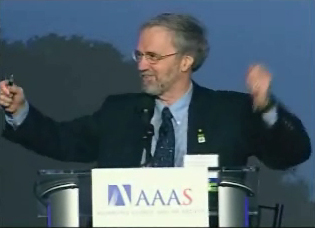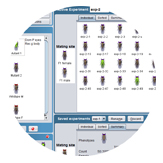Back to News Page
***************
February 2011
Watch Professor Walker’s AAAS 2011 Plenary Lecture*: Inspiration and Engagement in Education

Professor Graham Walker delivers plenary address at the AAAS 2011 Annual Meeting on February 21, 2011.
In his plenary address entitled Inspiration and Engagement in Education, delivered to the AAAS 2011 Annual Meeting in Washington, D.C. on February 21, 2011, HHMI Professor Graham Walker discussed research as a core element in science education.
Graham shared with the audience one of his dearly held educational goals: to teach students “how to see things that I didn’t know were there.” He offered several examples of discoveries made by students in inquiry-based undergraduate Project Laboratories at MIT that have led to new avenues of original research.
Graham talked about the importance of nurturing the incredible heterogeneity of learning styles to promote individuality among students. He drew a striking analogy between science education and the levels of resolution that can be achieved in bulk-experiments versus single-molecule experiments: “I think so often when we talk about education and we do assessments of education, it’s like doing bulk experiments in biochemistry. You can, for example, measure how much DNA has been replicated as a function of time, you can do it with great accuracy, standard deviations, the whole nine yards… but in recent years, people have been able to carry out single-molecule experiments and you get a different look at what’s going on because you can see the behavior of individual molecules within a population… and I’m struck by how much it’s like teaching”, marveled Graham. While hopefully all of the students in a class are heading in the same direction, recognizing the heterogeneity that exists in classrooms helps educators to identify the students that start out slow before taking off and the students that may need some extra help.
The importance of helping students to see science “as a human endeavor” was another key topic. Graham feels that he would be doing his students a disservice if he left them thinking that “Watson and Crick, two young geniuses, sat down with some X-ray diffraction data and out came the structure.” Instead, Graham walks his students through the “misadventures and missteps” that these researchers went through on their way to unraveling the structure of DNA. Graham went on to describe how he talks with his students about the human and societal complexities that are an integral and unavoidable component of research.

Professor Walker drew an analogy between heterogeneity among students and the heterogeneity observed in experiments that have single-molecule resolution, such as Professor Joe Loparo’s work at Harvard University to visualize replication of single molecules of DNA.
Graham highlighted work accomplished by members of his HHMI-supported Education Group, first established in 2002 and now active again, including the development of educational software tools such as StarGenetics and StarBiochem. Graham also summarized the science education initiatives of colleagues in the Society of HHMI Professors, pointing to the work of HHMI Professors Rich Losick (Harvard University), Isiah Warner (Louisiana State University), Jo Handelsman (Yale University), Scott Strobel (Yale University), Utpal Banerjee (University of California–Santa Cruz), and Graham Hatfull (University of Pittsburgh).
Graham also gave an inspiring demonstration of the value of OpenCourseware (OCW) resources. He shared with the audience a letter that he recently received from Mr. Brandon Adams, an individual who has made remarkable use of the Introductory Biology (Course 7.014) materials available through MIT OCW resources. Although Mr. Adams has no formal education in Biology, his independent studies using OCW resources have enabled him to secure a laboratory research position that would normally be reserved for someone holding a bachelor’s degree.
Like other faculty at major research universities, Graham admits to “walking the tightrope trying to balance research and teaching” in his career. But he adamantly declares that it is possible to build an extraordinarily productive and fulfilling career on that tightrope. Graham encouraged members of the audience to find opportunities for productive synergy between their teaching and research. “There are so many times that teaching and research can be synergistic, if you give them a chance.”
* Video published online with the permission of AAAS *2011.




